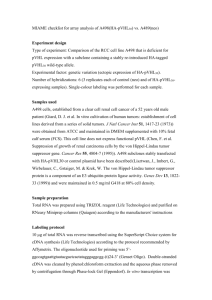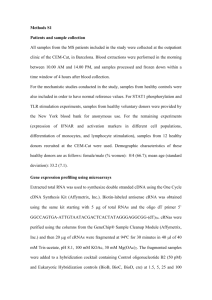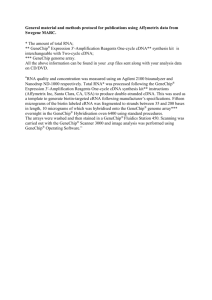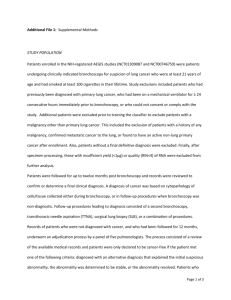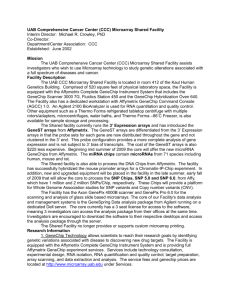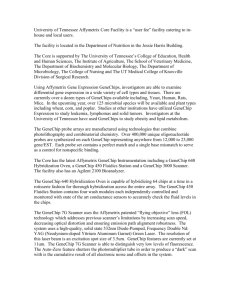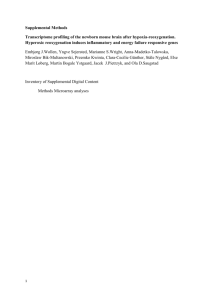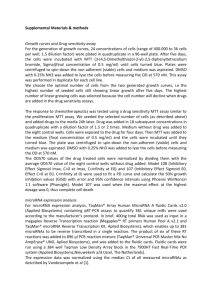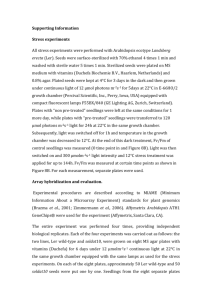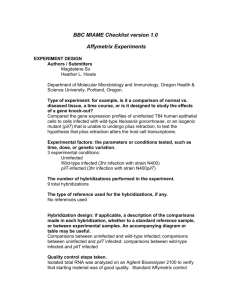nph12198-sup-0001-MethodS1
advertisement
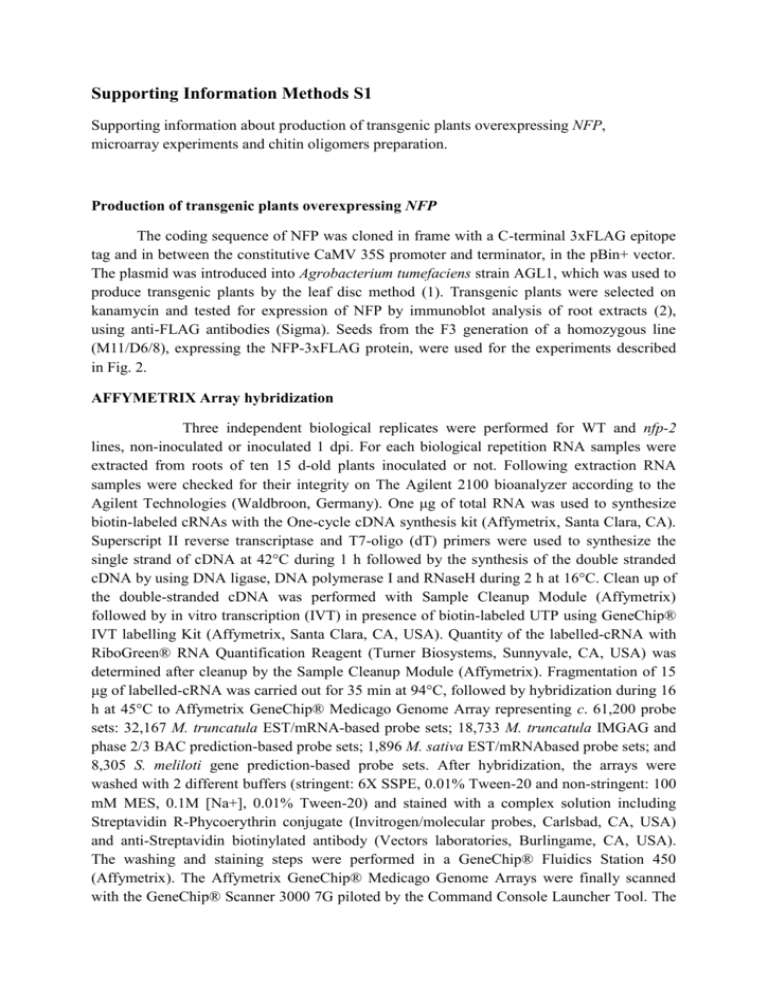
Supporting Information Methods S1 Supporting information about production of transgenic plants overexpressing NFP, microarray experiments and chitin oligomers preparation. Production of transgenic plants overexpressing NFP The coding sequence of NFP was cloned in frame with a C-terminal 3xFLAG epitope tag and in between the constitutive CaMV 35S promoter and terminator, in the pBin+ vector. The plasmid was introduced into Agrobacterium tumefaciens strain AGL1, which was used to produce transgenic plants by the leaf disc method (1). Transgenic plants were selected on kanamycin and tested for expression of NFP by immunoblot analysis of root extracts (2), using anti-FLAG antibodies (Sigma). Seeds from the F3 generation of a homozygous line (M11/D6/8), expressing the NFP-3xFLAG protein, were used for the experiments described in Fig. 2. AFFYMETRIX Array hybridization Three independent biological replicates were performed for WT and nfp-2 lines, non-inoculated or inoculated 1 dpi. For each biological repetition RNA samples were extracted from roots of ten 15 d-old plants inoculated or not. Following extraction RNA samples were checked for their integrity on The Agilent 2100 bioanalyzer according to the Agilent Technologies (Waldbroon, Germany). One μg of total RNA was used to synthesize biotin-labeled cRNAs with the One-cycle cDNA synthesis kit (Affymetrix, Santa Clara, CA). Superscript II reverse transcriptase and T7-oligo (dT) primers were used to synthesize the single strand of cDNA at 42°C during 1 h followed by the synthesis of the double stranded cDNA by using DNA ligase, DNA polymerase I and RNaseH during 2 h at 16°C. Clean up of the double-stranded cDNA was performed with Sample Cleanup Module (Affymetrix) followed by in vitro transcription (IVT) in presence of biotin-labeled UTP using GeneChip® IVT labelling Kit (Affymetrix, Santa Clara, CA, USA). Quantity of the labelled-cRNA with RiboGreen® RNA Quantification Reagent (Turner Biosystems, Sunnyvale, CA, USA) was determined after cleanup by the Sample Cleanup Module (Affymetrix). Fragmentation of 15 μg of labelled-cRNA was carried out for 35 min at 94°C, followed by hybridization during 16 h at 45°C to Affymetrix GeneChip® Medicago Genome Array representing c. 61,200 probe sets: 32,167 M. truncatula EST/mRNA-based probe sets; 18,733 M. truncatula IMGAG and phase 2/3 BAC prediction-based probe sets; 1,896 M. sativa EST/mRNAbased probe sets; and 8,305 S. meliloti gene prediction-based probe sets. After hybridization, the arrays were washed with 2 different buffers (stringent: 6X SSPE, 0.01% Tween-20 and non-stringent: 100 mM MES, 0.1M [Na+], 0.01% Tween-20) and stained with a complex solution including Streptavidin R-Phycoerythrin conjugate (Invitrogen/molecular probes, Carlsbad, CA, USA) and anti-Streptavidin biotinylated antibody (Vectors laboratories, Burlingame, CA, USA). The washing and staining steps were performed in a GeneChip® Fluidics Station 450 (Affymetrix). The Affymetrix GeneChip® Medicago Genome Arrays were finally scanned with the GeneChip® Scanner 3000 7G piloted by the Command Console Launcher Tool. The raw CEL files were imported in R software for data analysis.The data were normalized with the gcrma algorithm, available in the Bioconductor package (3). To determine differentially expressed genes, we performed a usual two group t-test that assumes equal variance between groups. The variance of the gene expression per group is a homoscedastic variance, where genes displaying extreme variance (too small or too large) were excluded. The raw p-values were adjusted by the Bonferroni method, which controls the Family Wise Error Rate (FWER) (4). Genes with a P-value lower than a Bonferroni-corrected P-value threshold of 9.82318E07 is declared differentially expressed. Chitin oligomers preparation Preparation of a chitin oligomers elicitor was adapted from(5): crab shell chitin (Sigma C3387) was finely ground, deproteinized by incubation in 1 M NaOH at 20°C for 1 h, washed in distilled water, and lyophilized. Partial hydrolysis was performed by incubation in 12 N HCl at 40°C for 100 min. After neutralization with KOH, the hydrolysate was dialyzed against distilled water at 1 kDa mol weight cut-off, lyophilized, and then analyzed on a BioGel P4 column (24x250 mm) in 100 mM NH4HCO2, pH 6.8. The column was calibrated with 1.1, 5 and 50 kDa dextran standards. Fractions corresponding to apparent molecular weights between 2,000 and 3,000 Da, and between 1,000 and 2,000 Da, were separately collected, resulting in two pools, which were lyophilized and solubilized in UHQ water. MALDI-TOF mass spectrometry analysis of the two samples, using 2,5-dihydroxybenzoic acid as the matrix in positive ion mode, detected the presence of chitoheptamer only in the pool of higher molecular weight, which was retained for plant elicitation. 1. 2. 3. 4. 5. Chabaud M, De Carvalho-Niebel F, & Barker DG (2003) Efficient transformation of Medicago truncatula cv. Jemalong using the hypervirulent Agrobacterium tumefaciens strain AGL1. Plant Cell Rep 22(1):46-51. Klaus-Heisen D, et al. (2011) Structure-Function Similarities between a Plant Receptor-like Kinase and the Human Interleukin-1 Receptor-associated Kinase-4. J. Biol. Chem. 286(13):11202-11210. Gentleman R & Hornik K (2002) R 1.5 and the Bioconductor 1.0 releases. Comput Stat Data An 39(4):558-559. Ge YC, Dudoit S, & Speed TP (2003) Resampling-based multiple testing for microarray data analysis. Test 12(1):1-77. Nars A, et al. (2013) An experimental system to study responses of Medicago truncatula roots to chitin oligomers of high degree of polymerization and other microbial elicitors. Plant Cell Reports:In Press.
